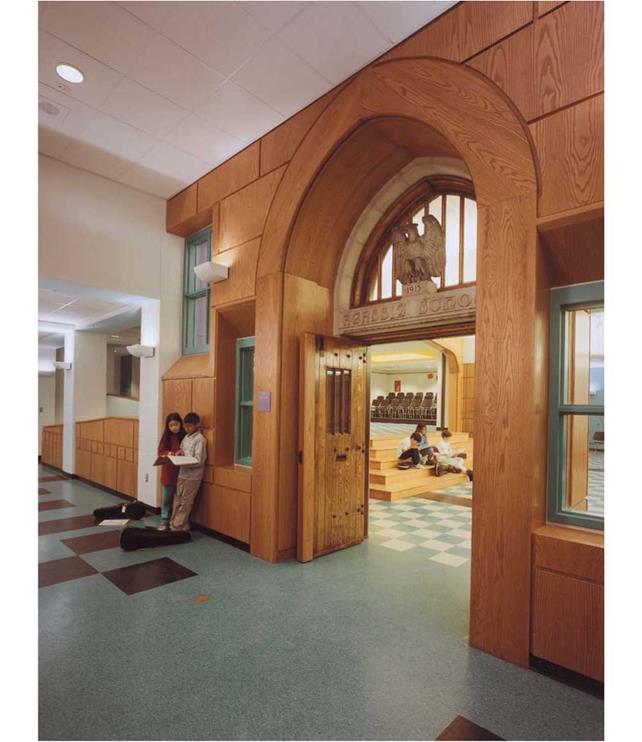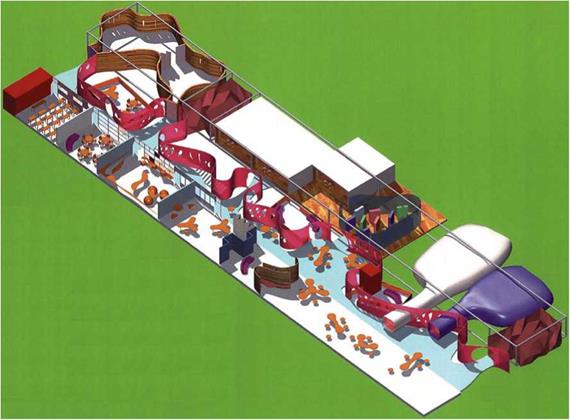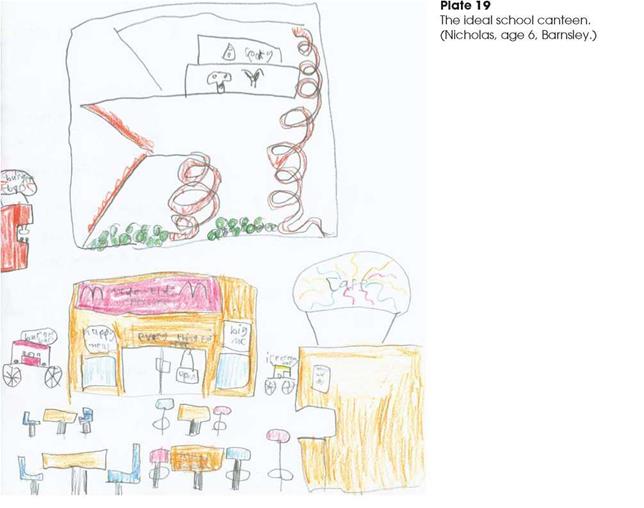Starting a garden is like planting seeds of hope for
future generations to have better lives___ Our
school grounds are going to be transformed into
something fertile and fruitful.71
On a global scale, school feeding programmes are perceived by agencies such as the World Food Programme to be the key to ending global hunger and associated inequalities. Drought and associated famine which strike areas such as Kenya immediately impact upon schools where children, especially girls, are withdrawn while their families cope with the short – or long-term crisis. UNICEF has reported a drop in school attendance of between 5 and 10 per cent in such areas at these times.
Poverty, hunger or malnutrition are usually associated with the non-industrialized majority world. But the incidence of child poverty is on the increase in many Western countries and providing nutrition in the school environment is regarded as a key to tackling wider problems of inequalities and related issues.72
In spite of major changes in the type and origins of food consumed in school there are important continuities over time which the historical perspective allows us to recognize. These continuities in children’s experience and culture underline the fundamental importance of the edible school landscape for children. They draw from it in ways that allow their creative impulse to become active. Food becomes a language of communication, a coded language that children know how to interpret from their collective play. Food represents survival which goes a long way to explain why it features so strongly when children of all ages are invited to describe or design their ideal school environment. This creative outlet is important to recognize and what the historical record testifies is that, in spite of the ‘McDonaldization’ factor, the evidence shows that young children will respond to the edible landscape in creative ways as long as they are allowed free time together to play or socialize in the school or schoolyard.
Food gardens mature over a growing season. Inspiring change in children’s appreciation of food takes time and the school projects where they exist are set against gigantic competition from the fast food industry and commercial food companies. Designing edible landscapes is an important part of the future of school, and listening to what children say they want, beyond hearing what is expected, is key to transforming, through design, the next generation’s attitude towards food and consumption.
Notes
1 Opie, I. and Opie, P. (1977). The Lore and Language of School Children. Frogmore, St Albans: Paladin. pp. 182-184.
Today, it is still possible to observe in any primary school playground the length and breadth of the UK, children chanting rhymes to accompany skipping and other games. Many of these feature food. Some contemporary examples might include:
Oh I wish I was a little round orange Oh I wish I was a little round orange I’d go squirty, squirty, squirty Over everybody’s shirty Oh I wish I was a little round orange!
North, South, East, West,
Cadbury’s chocolate is the best.
Jelly on a plate,
Jelly on a plate,
Wibble wobble, wibble wobble,
Jelly on a plate.
Milk, milk, lemonade,
‘round the corner, chocolate’s made! (A chant to accompany picking someone to be ‘on’ in a game of chase.)
Apple, strawberry, treacle tart,
I know the name of your sweetheart,
A, B, C,… . (skipping rhyme)
The rhythms are the same although the words signify a changed context,
A Pizza Hut, a Pizza Hut,
Kentucky Fried Chicken and a Pizza Hut. McDonald’s, McDonald’s,
Kentucky Fried Chicken and a Pizza Hut. (skipping rhyme).
2 The phrase ‘the white heat of technology’ was used by Prime Minister Harold Wilson after winning the UK General Election in 1964.
3 See for example ‘Enterprise guide, case study Cocktails and Canapes, UK National Curriculum, Design and Technology key stage 3 support materials.’ Food Technology pupils in Year 10 undertook a design and technology enterprise, working with local businesses, providing food for a large-scale event and then producing a recipe book for sale. The enterprise provided an insight into the food industry, illustrated the commercial value of food production, encouraged the pupils to find out about local food and required them to mass produce quality food products.
4 See for example Winterton, J. (2002) Multinationals, ready meals and malnutrition – why fat is a socialist issue. The Guardian, 26 February.
5 Although the school curriculum was never prescribed in Britain until the introduction of the National Curriculum in 1988, pre-war manuals for teachers such as Handbook of Suggestions for Teachers, published in 1927 by the Board of Education, devoted a whole chapter to gardening.
6 Stitt, S., Jepson, M., Paulson-Box, E. and Prisk, E. Food Skills in the National Curriculum: An International Perspective. Paper presented at BERA Annual Conference September 1996.
7 Worksheet ‘Control Systems for Bread making’. Ridgwell Press. Accessed March 2002 in use at key stage 3,13-14-year-old children, UK.
8 Arnhold, W., Dixey, R., Heindl, I., Loureiro, I.,
Perez, C. and Snel, J. (1995). The European Guide to Nutrition Education in Schools: Europe Against Cancer. Holstein: European
Commission.
9 In the UK, The Growing Schools Garden project is part of a wider government initiative, The Growing Schools Programme, launched by the Department for Education and Skills (DfES) in September 2001. The project aims to increase schools’ interest and involvement in outdoor education, using school grounds, farm visits and growing as a resource.
A key objective is ‘to help children understand where their food comes from, so they can make informed consumer choices and understand the benefits of a healthy diet and active lifestyle’.
10 The Henry Doubleday Research Association. Schools Organic Network. http://www. hdra. org. uk/ schools_organic_network/index. htm
11 See Brosterman, N. (1997). Inventing Kindergarten. New York: Abrams Books.
12 Handbook of Suggestions for Teachers (1927), Board of Education, London. H. M.S. O. p. 385.
13 Log book entry, Shurdington School, accessed via www. shurdington. org/oldschool. htm. During the Second World War in the United States, the Victory Gardens similarly employed children in growing food.
14 A full discussion of ‘The School I’d Like’ archive can be found in Burke, C. and Grosvenor, I. (2003) The School I’d Like. Children and Young People’s Reflection on an Education for the 21st Century. London: Routledge.
15 Blishen, E. (1969). The School That I’d Like. London: Penguin. p. 9.
16 ibid, p. 149.
17 The Guardian, Education Supplement, 16 January and 5 May, 2001, p.
18 The term ‘McDonaldization’ from Ritzer, G. (2000). The McDonaldization of Society. Pine Forge Press.
19 Gordon, T., Holland, J. and Lahelma, E. (2000). Making Spaces. Citizenship and Difference in Schools. New York: Palgrave McMillan Ltd.
20 ibid. p. 144.
21 From The Review of Reviews, April 1911. I am grateful to Kate Rousmaniere of the University of Miami in Ohio for references to early school meals provision in the United States.
22 L. A. Selby, 31 March 1909, quoted in Buckley, M. E. (1914). The Feeding of School Children. London: Bell and Sons Ltd. p. 83.
23 Latimer, R. (1935). Problems of Public School Cafeterias. Practical Home Economics, Vol 13, no. 6, p. 178.
24 Selby-Bigge, L. A. Report on the Working of the Education (Provision of Meals) Act up to 31st March 1909. p. 83.
25 Hansard, March 2, 1906.
26 Craddock, M. E.‘The School Lunch’ Texas State College for Women. College of Industrial Arts. Bulletin no 156. July 1, 1931.
27 The Lunch Hour at School. (1920) Evening Post, New York, July 10,
28 Buckley, M. E. (1914). The Feeding of School Children. London: Bell and Sons Ltd.
29 ‘The Builder’, 4/1/1890 cited in Clay, F. (1902). Modern School Buildings. London: B. T. Batsford.
p. 160.
30 Ringshall, R., Miles, M. and Kelsall, F. (1983). The Urban School. Buildings for Education in London, 1870-1980. G. L.C. London: The Architectural Press.
31 Ministry of Education Pamphlet no. 33, (1957). The story of post-war school building. p. 38. London: Her Majesty’s Stationery Office.
32 For a full analysis of the scale of corporate involvement in schools in the USA, a good place to start is the Center for the Analysis of Commercialism in Education, School of Education, University of Wisconsin – Milwaukee.
33 Captive kids: a Report on Commercial Pressures on Kids at School, Consumers Union, 1995. See
http://www. igc. org/consunion/other/captivekids/
pressures. htm
34 Shurdington school log, www. shurdington. org/ oldschool. htm#COCOA%20versus%20 HORLICKS
35 I am grateful to Ian Grosvenor for this reference discovered among papers at Birmingham City Council Education Library.
36 Information supplied by South Iceland Dairy.
37 BBC News 30 June 2000. In one school a pupil was suspended for wearing a Pepsi t-shirt on Coca-Cola day. Noble, M. ‘The Branding of Education’ in Global Social Justice. 30/01/2002. www. globaljustice. co. uk
38 Stitt et al., 1996.
39 The Guardian, 23 July, p.
40 Jackson, D. (2002). Chicago Tribune, 1, May, p.
41 Information taken from Burger King’s website, accessed March 2002. www. burgerking. com
42 www. burgerking. com. In 1999, Burger King was forced to recall an estimated quarter of a million Pokemon balls given away free to toddlers after a baby suffocated and died in California as a result of receiving one. BBC Online. Tuesday, 28 December, 1999, 19:43 GMT ‘Burger King in Pokemon recall’
43 Walkers’ website: www. walkers. co. uk. See also Geoff Rayner, Chair of the UK Public Health Association. ‘Today’s Lesson, Get Munching’ in Health Matters, issue 44, spring 2001. The Walkers’ showcase website is a National Grid for learning (NGfL) badged site. This means that the website applied to be included in the NGfL portal via the NGfL content registration form which can be accessed at: http://challenge. ngfl. gov. uk/gridreg
44 Brannigan, E. The School Lunch. A New York High School Cafeteria. Practical Home Economics, Vol 12, no. 11, pp.
45 Bard, B. (1968). The School Lunchroom: Time of Trial. New York: Wiley. p. 48.
46 Bard, op. cit., p. 103.
47 See www. schoolworks. org. uk
48 Notes from workshops coordinated by School Works, summer 2000.
49 Bard, op. cit., p. 30.
50 Bard, op. cit., pp. 53-59.
51 Alex Molnar, ‘Corporate Involvement In Schools: Time For A More Critical Look’. Center for the Analysis of Commercialism in Education, School of Education, University of Wisconsin-Milwaukee. Winter, 2001.
52 The Guardian, 23 July, p.
53 Mary Whiting, quoted in the Guardian 5 September, 2001.
54 Inter-Departmental Committee on Medical Inspection and Feeding cited in Buckley, op. cit. p. 37-38.
55 Focus: Healthy Eating. 11, pp.
56 Information supplied by South Iceland Dairy.
57 Focus on Food. www. rsa. org. uk RSA’s ‘Focus on Food’ Campaign is led and managed by the Design Dimension Educational Trust. The Campaign’s principal supporter is Waitrose, food shops of the John Lewis Partnership. See RSA Journal, June 2002, pp. 22-23.
58 Steiner Education Journal, November, 2001.
59 The term is taken from John Taylor Gatto
(1992) Dumbing Us Down: The Hidden
Curriculum of Compulsory Schooling. Philadelphia: New Society Publishers.
60 The first secular schooling supported through state funding in England was established in the heart of the workhouse.
61 I am grateful to John R. Gillis for the reference to ‘Islanding’ taken from his paper presented at the Designing Modern Childhoods Conference, Berkeley, California, May 2002.
62 The author’s mother has recounted how in her elementary school, a local landowner donated a plot of land for use by the school. This was in walking distance of the school situated in the north east of England.
63 Steiner Education Journal, November, 2001.
64 Moore is currently Director of The Natural Learning Initiative and Professor of Landscape Architecture in the School of Design, North Carolina State University. For information about the Natural Learning Initiative, see www. naturalearning. org
65 Moore, R. cited in Penner, T (1999) Grandview Community Schoolyard. School Ground Revitalization Project, Graduation Project. U. B.C. Department of Landscape Architecture
66 Jed Lawson, Coordinator of Berkeley Schools Food Project.
67 Pennington, G. cited in School Garden Guidelines (1989). Published by City Farmer and Imperial Oil Limited. p. 5.
68 Penner, T. (1999). Grandview Community Schoolyard. School Ground Revitalization Project, Graduation Project. U. B.C. Department of Landscape Architecture. p. 4. The project coordinator was Illene Pevec.
69 Penner, T. ibid. p. 45.
70 The breakfast programme is sponsored by a local bank.
71 Sam Fillipoff in Knickerbocker, N. Community spirit blooms in Grandview garden. Teacher Newsmagazine, Volume 13, Number 1, September 2000.
72 The School Children’s Food Foundation of Newfoundland and Labrador was formed in 1994 to provide information and funding required to establish and sustain breakfast, lunch and snack programmes in schools and community centres throughout the province.
Illustrations
All photographs by C. Burke apart from:
Figure 12.1 Serving the School Dinner, from Armfelt, R. (1950). Our Changing Schools. A Picture for Parents. Prepared for the Ministry of Education by the Central Office of Information, London: HMSO, p. 34.
Figure 12.2 Findern School, from HDRA Organic Schools Network website.
Figure 12.3 Children’s Garden, from Bosterman, N. (1997). Inventing Kindergarten. New York: Abrams, p. 37, credited to Zindman/Freemont New York.
Figure 12.4 ibid, p. 31.
Figure 12.5 Featherstone School Collection.
Figure 12.6 By Jamie Proud.
Figure 12.8 Roof top, New York, from The Review of Reviews, New York, April 1911.
This page intentionally left blank
This page intentionally left blank
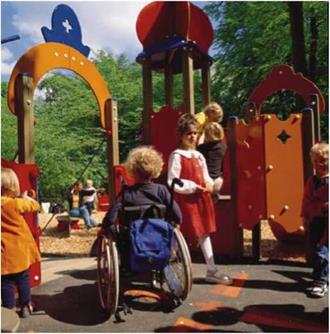 Plate 1
Plate 1
The new castle – anchor and all. (Photos: Kompan.)

Plate 2
An old bent crooked tree… a wonderful tree, in Guell Park, Barcelona. (Photo: M Laris.)

Plate 3
Colour variation promotes invention.
(Photo: Kompan.)
|

 Plate 5
Plate 5
Warm burnished brickwork is embellished with decorative iconography. Crow Island School, Winnetka, Illinois.
|
|
Plate 6
View into the main hall showing the door case from the original school building, fully integrated into the new building. Thompson Middle School, Newport, RI, designed by HMFH Architects, Cambridge, MA. (Photo: Jonathan Hillyer.)
Plate 7

 King Alfred School, Hampstead, London. Interior of classroom: an ordered, calm environment. Van Heyningen and Howard Architects. (Photo: Dennis Gilbert.)
King Alfred School, Hampstead, London. Interior of classroom: an ordered, calm environment. Van Heyningen and Howard Architects. (Photo: Dennis Gilbert.)
Plate 8
Ballifield Community Primary School, Sheffield: new entrance and classroom. (Architect: Prue Chiles.)
Plate 9
 Ballifield Community Primary School, Sheffield: exterior of classroom. (Architect: Prue Chiles.)
Ballifield Community Primary School, Sheffield: exterior of classroom. (Architect: Prue Chiles.)
 Plate 10
Plate 10
Children’s toilets are designed to the same standard as the classrooms, which encourages a healthy attitude.
|

 Plate 12
Plate 12
A small personal pod equipped with sofa, beanbag and cushions; supplied with a dream cassette machine and a rack of computer games.
|

wnat is a locker?

![]() Investigating Personal Spaces.
Investigating Personal Spaces.
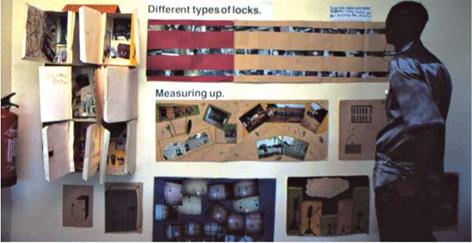
 Plate 15
Plate 15
Conceptual section through the classroom of the future with Real Time Global Schools Learning Link Up and Virtual Classroom Field Trip Link Up. ALSOP Architects.
|
|
|
|
Plate 16a, b
We can predict that in the future, teaching will take place in a variety of group sizes ranging from 90 students to the traditional 30 pupils per class. ALSOP Architects.

|
|
|
|
Plate 18 Volcano school. |
|
|

|
Plate 21
 The edible schoolyard, Martin Luther King Junior Middle School, Berkeley, California. (Photo: Cathy Burke.)
The edible schoolyard, Martin Luther King Junior Middle School, Berkeley, California. (Photo: Cathy Burke.)
|

1 A secure fenced and gated entry system should be put in place enclosing an area equal to the maximum extent of the ‘riders’ in motion plus two metres in all directions.
3 Safety inspections on ropes and fastening points should be undertaken daily and a close inspection should be made each week.
1 The self-build platform had neither handrails, guard rails or any safety surfacing, incorporated unexpected obstacles as well as head and torso traps, and so represented apparent risk to users.
2 The ‘Spider climber’ incorporates hard objects in the falling area and lacks a safety surface.
3 Parallel bars invariably attract children, usually girls to hang head down like bats with their legs wrapped around a bar. The absence of safety surface suggests high risk in the event of losing grip.
[1] As individuals;
[2] Pupils taught directly by their teachers;
[3] Appropriateness. What resources are needed
to support the learning processes which are expected to take place?
[5] Knowledge, skills and understanding – what is to be taught in the subject during the key stage.
• Breadth of study – the contexts, activities areas of study and range of experiences through
[6] The safety surface should be restored and extended by at least a metre to all sides.
[7] Monumental, 1880s-1920s. This period is characterized by twenty-foot-high massively
[8] A subjective judgment made to indicate an absence of obstructions or specific barriers
2. As (1) above but with abacus, shape sorts, slider panels, pinball games or similar ground level based activities
3. As (2) above but with ropes, handrails, grab handles or other self-help access aids in place. Ideally at least half of the elevated sections are accessible
4. As (3) above but with transfer platforms, ramps, low-level shallow access, and/or a protective surface finish for comfortable access or return crawling. An accessible return route to original start point, ground or elevated level is presumed in this case
5. As (4) above where relevant, but with dual or multiple user roles such as speaker tubes, tic-tac-toe, sand tables, water play and shop fronts. Inclusivity is a ‘stand alone’ concept only in part dependent upon accessibility considerations
[9] We sometimes tolerate poorly designed and even dangerous play equipment. The simplest solution to this aspect of a greater problem lies in planned programmes of public education and the spreading of good practice through partnership, with the play equipment industry leading the way.
• Economic considerations and mistaken social attitudes are sometimes allowed to influence the location of play equipment and play space. So the play area goes where the developer can’t build a house or the land is poor or at a considerable distance from the houses of people who don’t like the noise of children at play.‘The road isn’t really dangerous’, some say, ‘It’s just that the cars go too fast.’
• We are sometimes reluctant or unable to insist that play equipment is adequately maintained throughout its life and to recognize
[10] Sensorimotor planting circle.
2 Plantings at the arch climber.
3 Plantings at the bridge of the main play structure.
[11] Children themselves, explored through their ideas and designs for change in the school environment.

